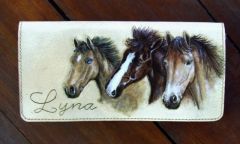-
Posts
2,245 -
Joined
-
Last visited
Content Type
Profiles
Forums
Events
Blogs
Gallery
Everything posted by Ferg
-
Now, you see you have your method and I have mine. Yours works for you and mine for me. I have tied off the thread and I have glued the tips with super glue. Some folks burn the ends. For you to say that tying off by hand is the correct practice simply is not necessarily true. I will continue to use the leather needles no matter if I reverse or not. I agree that you can sew leather with a round point IF you use an oversize needle. Personally I don't like a thread hole that I can drive a truck through. Simply like what I get with a leather needle. I am glad you like the round point but don't try to convince me that your way is the best, it just works for you. ferg
-
One of my daughters is a Caregiver. None of our family would have thought she would be one to do this, she loves it. We are proud of her. ferg
-
I think you done a very good job on the edge, especially since you hand stitched. Nice color choice on the leather and thread. ferg
-

Computer Drawing Software For Making Leather Patterns
Ferg replied to Blackey Cole's topic in Computer Help
Curious to know what the financial damage is on the machine you have. ferg -
Go to this site: http://www.thethreadexchange.com/miva/merchant.mv?Screen=CTGY&Store_Code=TTE&Category_Code=nylon-thread-information to get much information on thread. A must read for many sewing machine beginners. ferg
-
LesNo6, You are giving some tainted information there. Leather point needles are for stitching leather because they cut/pierce the leather so the remainder of the needle and thread can do it's thing. Round point needles are for fabric, canvas, and vinyls etc. If the machine is perfectly timed I would bet the needle will return into exactly the same hole without cutting the thread. ferg
-

Computer Drawing Software For Making Leather Patterns
Ferg replied to Blackey Cole's topic in Computer Help
I am referencing your third paragraph. I see nothing on this company site that would suggest they have a machine that will trace onto leather. The machines are all "cutters". Can you clarify? ferg -

Computer Drawing Software For Making Leather Patterns
Ferg replied to Blackey Cole's topic in Computer Help
Bobby, I have an Epson printer that will print 13 x 18, very handy for making drawings on Vellum. There is always a down side, this particular printer has a thirst for ink. Illustrator makes it possible to draw on any size you wish, dependent only on your monitor size. Simply print the actual size you need. My hand is not steady enough to do much drawing by hand. This is where the drawing programs hit the sweet spot. ferg -
I have used the 2oz calf skin for the wrapped edge. Looks absolutely beautiful if you keep your stitches perfectly aligned. I like a slightly different shade of dye on the wrap than body of bag. ferg
-

Computer Drawing Software For Making Leather Patterns
Ferg replied to Blackey Cole's topic in Computer Help
Your wacom drawing can be copied to Photoshop but you must remember, Photoshop is not a designing platform, you need Illustrator to move your drawing from the tablet. You can resize much easier and keep everything in proportion at the same time. There are some less expensive drawing programs, you need to check the specs to see if they will import from the Wacom. ferg -
Normally if it is on 120 volts doesn't matter which wire is to the posts, technically. If you reverse the wires and the hot wire happens to be connected to the case of the motor you will get shocked every time you touch it. If motor is on 220 volts you can reverse the motor by exchanging the two hot wires, leave the ground wire alone. That said: I would bet he screwed up the parts when he put them back in. ferg
-
This company has many fine looking items. You do realize they are in the Czech Republic? ferg
-
Welcome to the worlds greatest Leather site, let's see some pics soon. ferg
-

Hello Gents And Ladies
Ferg replied to smoke10's topic in Gun Holsters, Rifle Slings and Knife Sheathes
Your work looks very nice but I would like to see it all without scrolling, scale your photos down please. ferg -
This is a filigree done with shaped punches. You would normally place a contrasting color behind this.
-

Ladies purse. Horses was fun for a change :)
Ferg commented on Anet du Toit's gallery image in Our Leatherwork Galleries
-
Seen your other photos of the case. You done an excellent job with the style, pattern, and workmanship. I like your finger cuts also. ferg
-

Making Evergreen (Spuce) Type Trees In Leather?
Ferg replied to jestermg's topic in How Do I Do That?
I downloaded a couple of the doodle pages. I remember some of them many years ago were very enlightening. Unfortunately, the ones I have seen are not so. The book I mentioned above is still the best $15 you will ever spend. ferg -
This may help you. Each ounce of leather is 1/64" or 0.396875mm. Eight ounce leather 1/8" or 3.175mm. Hope this helps a little. ferg
-
Tandy for starters but there are many outlets for the dye. Google "Leather Dye". ferg
-

Making Evergreen (Spuce) Type Trees In Leather?
Ferg replied to jestermg's topic in How Do I Do That?
You need a copy of Al Stohlman book: Pictorial Carving Finesse. This book has many different types of trees and bushes with tool selection and how to use them. The book was written some time ago so there may be some tools shown that are not available anymore. There is almost always a good substitute though. ferg -
Hi Valery, Your English is very good as is your work. Stitching is good, you need to glue the ends of your stitches. Cut the thread as close to the last stitch as possible then put a drop of Super Glue or similar directly on the thread. That will prevent the last thread from coming loose with wear. ferg
-
There are "piping" feet for many machines that are made differently than the one shown. I have three different sizes for my Consew, 3/8", 1/4", and 1/8". These feet have a slot in the bottom that rides over the piping and stitches right against the bead. Hmmmmm, I didn't think the music was all that bad. There are many more tutorials on You Tube for doing Piping and/or Welting with a person speaking with what they are doing. ferg
-

Options For Finishing Wallet Edges Besides Braiding
Ferg replied to equiss's topic in How Do I Do That?
Chaylor-Fennelli has very nice liners, Springfield has them. The liners from Tandy are from across the "Pond" and of questionable quality. I have found a few through Google from other sources but not many. Most if not all good wallets in retail establishments are sewn not laced. A sewn wallet has class if it is done correctly. Access Bob Park's (hidepounder) tutorial on finishing/burnishing edges. -
I assume you are sewing a material other than leather since you are using 135 x17 needle. The long slot in the side of the needle should be to the left side, thread needle from left to right. A good test for sizing on thread and needle is to thread a needle, hold the thread at about a 45 degree angle. If the needle slides down the thread easily you have the right size needle for the size thread you are using. Do not adjust needle, it should be placed all the way up into the hole for the needle. If you place the needle other than that the timing will be off. Make sure your machine is threaded properly. On occasion my Consew will "flip" a thread off the lower tension discs making it wrap around the knurled knob. That throws the tension off and also will shred the thread. If you have messed too much with the needle etc. you may have messed up the timing. Your manual gives information on timing. ferg




